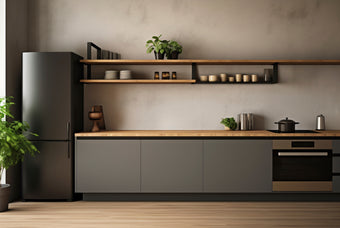Most popular
Introduction:
Welcome to the comprehensive guide that will unravel the mysteries of vinyl flooring and equip you with the knowledge needed to make informed decisions for your home. In this ultimate guide, we will delve into the world of vinyl flooring, covering everything from types and installation to maintenance tips and benefits.
Understanding Vinyl Flooring:
What is Vinyl Flooring?
Vinyl flooring is a versatile and resilient flooring option that has gained popularity for its durability, affordability, and wide range of design possibilities. It is a synthetic flooring material made primarily from polyvinyl chloride (PVC) and other additives that contribute to its strength and flexibility. Vinyl flooring can mimic the appearance of various natural materials, such as wood, stone, or tile, making it a cost-effective alternative to these traditional flooring options. There are different types of vinyl flooring, including Luxury Vinyl Plank (LVP), Vinyl Sheet Flooring, and Vinyl Tile Flooring. Each type offers unique features and advantages, catering to different preferences and requirements.-
Luxury Vinyl Plank (LVP): LVP is designed to replicate the look and feel of hardwood flooring. It consists of individual planks that can be easily installed, often featuring realistic wood grain patterns and textures.
-
Vinyl Sheet Flooring: Vinyl sheet flooring comes in large, continuous sheets and is ideal for covering larger areas with minimal seams. It is a practical choice for high-moisture areas like kitchens and bathrooms.
-
Vinyl Tile Flooring: Vinyl tiles are crafted to resemble ceramic or stone tiles. They come in a variety of shapes and sizes, allowing for creative patterns and designs. Vinyl tiles are popular in both residential and commercial settings.

Benefits of Having Vinyl Flooring?
-
Durability and Longevity: Vinyl flooring is known for its exceptional durability, making it a suitable option for high-traffic areas in both residential and commercial spaces. It can withstand the wear and tear of daily activities, making it a long-lasting flooring solution.
-
Water Resistance: Vinyl flooring is highly resistant to water, making it an ideal choice for moisture-prone areas such as kitchens and bathrooms. This water resistance helps prevent damage from spills, leaks, and humidity, providing peace of mind for homeowners.
-
Variety in Design Options: Vinyl flooring offers an extensive range of design options, allowing you to choose styles that mimic the appearance of natural materials like hardwood, stone, or tile. Whether you prefer a classic or modern look, vinyl flooring provides versatility to match your aesthetic preferences.
-
Easy Maintenance: Vinyl flooring is incredibly easy to maintain. Regular sweeping and occasional mopping are usually sufficient to keep it clean and looking new. Unlike some other flooring materials, vinyl does not require extensive or specialized cleaning routines.
-
Affordability: One of the most attractive aspects of vinyl flooring is its affordability. It provides a cost-effective alternative to more expensive materials like hardwood or stone while still delivering a stylish and durable flooring solution.

Installation Process:
Pre-installation Preparation: Before embarking on the installation of vinyl flooring, thorough pre-installation preparation is essential to ensure a smooth and successful process. Here are key steps in this phase:-
Subfloor Inspection: Inspect the subfloor for any damage, unevenness, or moisture issues.
-
Acclimatization: Allow the vinyl flooring material to acclimate to the room's conditions.
-
Measurement and Layout: Measure the room accurately, considering any nooks, corners, or irregularities.
-
Moisture Testing: Conduct a moisture test on the subfloor, especially in areas prone to moisture, such as basements or bathrooms.
-
Subfloor Preparation: Ensure the subfloor is clean, dry, and level
-
Underlayment Consideration: Determine if an underlayment is required based on the type of vinyl flooring being installed.

DIY vs. Professional Installation:
Choosing between a do-it-yourself (DIY) installation and hiring a professional installer depends on factors such as your skill level, the complexity of the project, and your comfort with the installation process.-
DIY Installation: DIY installation is feasible for those with basic skills in measuring, cutting, and following instructions. Many vinyl flooring products, especially click-lock systems, are designed for straightforward DIY installation. It can save on installation costs but requires careful attention to detail.
-
Professional Installation: Complex installations, intricate patterns, or large areas may benefit from professional installation. Professionals have the experience and tools to handle challenges, ensuring a high-quality, efficient installation. While it involves additional costs, professional installation can provide peace of mind and a polished finish.

Step-by-Step Installation Guide:
-
Starting Point: Begin the installation from the center of the room or along the longest wall, following the layout plan created during pre-installation preparation.
-
Adhesive Application (If needed): Apply adhesive to the subfloor if installing peel-and-stick vinyl tiles or planks. Follow the manufacturer's instructions for the type of adhesive and the application process.
-
Interlocking (For Click-Lock Vinyl): If using click-lock vinyl planks or tiles, interlock the pieces by angling and snapping them together. Ensure a tight fit to avoid gaps.
-
Seaming (For Vinyl Sheets): Seam vinyl sheets together using the recommended adhesive. Use a seam roller to create a secure bond and a smooth surface.
-
Trimming and Finishing: Trim excess material along the edges using a straight edge and a sharp utility knife. Install baseboards or molding to cover expansion gaps and create a finished look.
Cleaning and Maintenance:
Thoroughly clean the newly installed vinyl flooring. Follow the manufacturer's guidelines for recommended cleaning and maintenance to preserve the appearance and longevity of the floor. Always refer to the specific instructions provided by the manufacturer of your vinyl flooring product for the most accurate and detailed installation guidance.
Vinyl Flooring vs. Other Flooring Options:
|
Criteria |
Vinyl Flooring |
Hardwood |
Laminate |
Tile |
|
Durability |
High durability resistant to scratches and moisture |
Durable but may scratch and prone to water damage |
Durable but may scratch and prone to water damage |
High durable resistant to scratches and water |
|
Cost |
Affordable |
Expensive |
Moderate |
Varied |
|
Installation |
DIY-friendly, easy installation |
Can be complex, may require professional help |
DIY-friendly, easy installation |
Labor-intensive, may require professional help |
|
Maintenance |
Low Maintenance and easy to clean |
Requires regular maintenance, refinishing |
Requires regular maintenance and cleaning |
Regular Cleaning and Grout Maintenance |
|
Aesthetics |
Mimics various, materials, versatile designs |
Classic and timeless appeal |
Varied designs, may not replicate natural materials |
Diverse styles, luxurious look |
|
Comfort |
Comfortable underfoot |
N/A |
Comfortable underfoot |
Cold feel, hard surface |
|
Water Resistance |
Highly resistant |
Prone to water damage |
May not be as resistant as vinyl |
Resistant to water |
|
Versatility |
Versatile designs, mimics different materials |
Limited by wood species |
Varied designs, replicates various materials |
Diverse styles, can mimic natural materials |
Tips for Choosing the Right Vinyl Flooring:
To choose the right vinyl flooring, start by establishing a budget and understanding the specific needs of the space, considering factors like traffic and moisture levels. Familiarize yourself with the different types of vinyl, such as Luxury Vinyl Plank (LVP), Vinyl Sheet Flooring, and Vinyl Tile Flooring, and choose the one that aligns with your lifestyle. Evaluate the durability of the vinyl by checking the wear layer thickness and opt for a thicker layer for increased resistance against scratches and dents. Consider the installation method, assessing whether you prefer a DIY-friendly click-lock system or professional installation. Take into account the design and style that complements your existing decor, and check for eco-friendly options if sustainability is a priority. Reading customer reviews, requesting samples, and comparing warranties can provide valuable insights before making a final decision.
Explore GlobalFair to get the best quality Vinyl Flooring
Empty content. Please select category to preview
Join our newsletter now
Promotions, new products and sales. Directly to your inbox.





